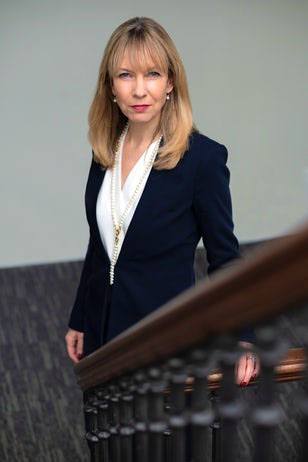As highlighted in previous issues of fivehundred, the backgrounds and experiences of chambers chief executives are broad and varied; they come from the traditional clerking ranks, the armed forces, the public sector, education, marketing and advertising, and, yes, the legal profession itself. Rebecca Priestley comes from the latter, but unlike her contemporaries she has held a role at every stage of the legal supply chain, giving her a unique insight into what lawyers of all stripes can and must do better.
Beginning her legal career as a barrister at 2 Gray’s Inn Square, Priestley practised employment and family law between 1994 and 2000 before cross-qualifying as a solicitor and joining Simmons & Simmons’ employment team in London. After another six years of private practice, she moved in-house, joining Standard Chartered Bank in 2006 as head of HR legal, managing the bank’s employment issues across Europe, the Americas, Asia, Africa, and the Middle East. Five years on, Priestley moved to Lloyds Banking Group where she spent eight years in various roles, first as head of HR legal and finally people director, employee relations and policy transformation.
In January 2019, Priestley’s career came full circle when she returned to the Bar as the new CEO of Outer Temple Chambers. UK Bar editor John van der Luit-Drummond sat down with Priestley to talk about her career to date, the evolution of the Bar, and her aspirations for chambers. John van der Luit-Drummond: Barrister, solicitor, in-house counsel – how has your journey through the legal professions and various businesses prepared you for your new role in chambers?
Rebecca Priestley: I’ve been fortunate to hold roles which have given me a very rounded view of legal services, a good perspective on what clients are looking for in legal advice, and an appreciation of the business context in which the advice plays out.
I have also been fortunate to work in a banking environment, which is having to change at an unprecedented pace to keep up with changing customer needs and behaviours, driven by digital disruption (‘The fourth industrial revolution’). Customer expectations are now influenced by Uber, Google, and Amazon, who provide immediate, seamless, and digital services. This digital disruption has brought about more change in the last decade to the way banking services are provided than we’ve seen in the previous 250 years. Continuing to provide banking services in the same way to customers is not an option.
Banks have had to adapt very quickly, transforming both the way they provide customer services and their internal ways of working and skill sets. Part of my role at Lloyds was to design people policies and promote positive employee relations to underpin this fundamental transformation.
JvdLD: How does your experience in the banking sector translate to the Bar?
RP: Working in banking focuses you on thinking about customers first and the ‘end-to-end customer experience’. This holds good in any professional services environment. For a barrister, being good on the day is now a given. What distinguishes and influences return instructions is your client’s entire experience from first interaction with chambers to follow up at the end of the case.
Solicitors rightly expect people skills as well as intellect – working well as part of a team is critical, as is the ability to read the room, manage clients well, and adapt to changing dynamics. If met with unresponsive, arrogant or unhelpful service at any point of that interaction, clients may simply move their custom elsewhere.
For the Bar, while the core offering of excellent advice and advocacy remains the same, the external environment to which those services are being supplied has changed significantly, influencing how clients expect to access, experience, and fund services.
JvdLD: In your LinkedIn bio you highlight having ‘a track record of implementing strategic organisational and cultural change, and fostering positive employee relations’. How is this likely to play in chambers, which is obviously very different from a law firm or bank?
RP: You’re right! A chambers is a world away from a FTSE 100 company with 70,000 employees. However, underpinning positive employee relations and culture in an organisation of any size is good, transparent communication, being clear about your common goals and values and what you stand for, working collaboratively to achieve results and fostering engagement and wellbeing, and a sense of collective pride in your brand and purpose. And also making sure people have some fun!
JvdLD: More and more chambers are embracing the CEO role. For this position, do you think having a legal background gives you an advantage over those without one?
RP: I wouldn’t go so far as to say that having a legal background is an advantage over those without such a background in the CEO role. There are some very successful chambers CEOs who don’t have a legal background. Having a strong customer-oriented approach and business development skills is key.
However, having practised myself, I certainly find it helpful as I can empathise with the challenges facing barristers. I also, I hope, have a fair appreciation of what users of legal services are looking for, and certainly what may wind them up. It also means you are fairly well networked within the legal profession and hopefully trusted to understand the issues clients may be facing in managing their practices and costs.
JvdLD: So, what do you think solicitors and barristers could be better at? What winds up clients?
RP: Businesses want certainty and to have clear commercial risk-based legal analysis and recommendations, rooted in an understanding of their business environment. Appreciating the potential financial, reputational, and practical consequences for your client of taking a certain course is important.
When you are presenting a legal issue for discussion and decision, to an executive committee or board, you need to be succinct. You will have a short slot in a busy agenda, and your presentation will be in a set format, with an executive summary.
In that context, a lengthy legal opinion, without a brief summary of the advice, options and recommendations, is not helpful. Solicitors and barristers could help in-house counsel by understanding their internal business and governance and asking clients how they want advice presented. That’s why secondments for barristers and solicitors can be helpful as an eye opener to the realities of the commercial world in which the advice is being given, and building a deeper understanding of your client’s business.
Pricing is also key. All clients, including FTSE 100s, have costs pressures and want clarity and certainty on costs as far as possible. Moving to more predictable, flexible, fee arrangements is definitely an ongoing trend.
Working with a strong team mentality is critical. I think chambers could market more around team and practice area capabilities, as against the individual. Strong personal relationships with your trusted legal advisers remains critical, but clients are also very open to being offered teams, particularly to support complex needs. Increasingly clients also rightly expect to be offered diverse teams in the provision of legal services.
JvdLD: What attracted you to return to chambers after almost two decades away?
RP: I have great admiration for the Bar and respect for barristers. The Bar has maintained its reputation for excellence and integrity at a time when many professions have suffered a crisis in public confidence. The independence of the Bar and its commitment to uphold the rule of law is a core pillar of our democracy, which is particularly important in our current turbulent times.
Being a barrister requires resilience, courage, and intelligence. Of all the things I have done in my career, appearing in court was the most daunting – no board room presentation comes close. It’s also a phenomenal training ground – having to marshal facts under pressure, and manage your case, client, opponent, the judge, and your nerves all in a day’s work.
I valued the opportunity to return to the Bar, being close to where law is being made, and look forward to using my experience over the last 20 years, in private practice and financial services, to support barristers discharging their important role.
JvdLD: How do you think the Bar has evolved since you were in practice?
RP: In some ways it has evolved, and in others the pace of change has been disappointingly slow.
On the positive side, I think the Bar has become more self-aware and commercial and recognised the need to adapt to changing client needs and a more competitive market. Some chambers have moved faster on this than others. One of the reasons I was attracted to Outer Temple Chambers is that it is progressive, innovative, and international. For example, OTC has opened offices in Dubai, Abu Dhabi, and New York.
Andrew Spink QC, one of our heads of chambers, is also chair of the Commercial Bar Association, and a justice in the Astana International Financial Centre in Kazakhstan which was officially launched last year and, like the DIFC and ADGM, affords opportunities for the Bar to advise and appear in international financial disputes in those forums. I also like the fact that Outer Temple also has a strong commitment to equality and diversity, with ‘blind’ recruitment practices, and Platinum Investor in People status.
JvdLD: That’s the positive. What about the negative?
RP: Where the pace of change has been disappointingly slow, is on diversity. On gender diversity, only 16% of silks are female. I think this needs a raft of measures and cultural change to shift the dial. I also think the Bar should set a target for female silks – I’d like to see 50% by 2025. I think if individual chambers made diversity a core business issue – rather than a side ‘HR’ issue – and set a target for female and BAME silks with a deadline, this would help shift the dial.
Setting a target is an important statement of intent and prioritisation, and what gets measured tends to get done. The target is tracked and measures are put in place to support career progression. This would reflect what happened in the City.
Helen Morrissey’s established the 30% Club in 2010, with a target to reach 30% gender diversity on FTSE 100 boards, which was met by 2018. Critical to this success was that boards made gender diversity a business priority, recognising that diversity positively impacts decision making and profitability. It makes business sense for your workforce to mirror your client base and increasingly in-house counsel and solicitors expect chambers to present diverse barrister panels.
JvdLD: What practical advice would you give to women looking to progress at the Bar?
RP: Be confident in your abilities and know your value and worth and expect support from your chambers and clerking team to help structure and plan your career progression.
Recognise that your career is a marathon not a sprint. Careers are getting longer and in the future people will change careers far more often. In the workplace more broadly, something like 40% of today’s jobs won’t exist in 2035, driven by digital disruption. Coming to the Bar after a career break or doing other jobs is often very beneficial-giving you a broader skill set and perspective. The good thing now is that there is plenty of time to flex what you do and when you may want to push for silk.
At Outer Temple we recognise that there is considerable scope to structure careers so that, for example, you may not want to be in court five days a week when you have young children, but you may be happy to ramp this up when they are older and in the run up to a silk application.
In addition, choose the right partner – look at Ruth Bader Ginsberg! Take care of your own health and wellbeing, and be kind to yourself. Quiet the inner self critic – we’re often our own worst critics; and have a strong friendship group and support other women. Madeleine Albright was quite right in saying there is a special place reserved in hell for women who don’t support other women!
In addition to the practical measures which chambers can put in place to help support women’s progress – mentoring, career breaks if needed, structured career planning – we are beginning to see cultural change in a gradual move towards greater equality in child care, underpinned by shared parental leave policies. The more mothers and fathers share responsibility for child care, the healthier an environment we create for both men and women and the more we decrease the adverse impact on women of shouldering all the responsibility for children’s care.
JvdLD: You’re also a non-executive director of the City Mental Health Alliance, a collection of FTSE 100 financial services companies and Magic Circle law firms, established to promote wellbeing in the City and breakdown stigma around mental ill health. What can the Bar do to promote better wellbeing?
RP: We all have mental health in the same way we all have physical health. One in four of us will be affected by poor mental health at some point in our lives. The chances of us being affected or a member of our family is statistically very high. While some of us may have a condition we manage, others may find our mental health impacted adversely at times, whether it’s by work-related stress, or life events such as bereavement, divorce, or the mental or physical ill health of our loved ones.
The Bar is in many ways behind the City in support and openness around mental health. This is perhaps not surprising. Working long hours, often in isolation and under considerable pressure in an ‘always on’ digital environment clearly makes you vulnerable to poor mental health. Being self- employed and feeling you are instructed for your personal resilience as well as your intellect means those whose mental health is under threat may be less likely to be open about it or to seek help, and chambers may not have the infrastructure in place to help.
I think the Bar is addressing this issue, and a lot of great work has been done by the Bar Council, but more is needed, particularly to encourage openness and destigmatise mental ill health. This will take some courageous senior barristers to act as strong role models by speaking up about their mental health, how they sought help, and the fact it was not career ending.
This is absolutely not about asking everyone to bare their soul. I fully appreciate the desire for privacy. However, it is important to break down stigma and encourage openness and self-help. We know suicide is the biggest killer of men under 50, and if some senior male leaders take this brave step it will encourage others to know they can feel safe in reaching out for help when they need it.
JvdLD: What will you do at Outer Temple to promote better wellbeing?
RP: Within chambers, there is positive feeling about wellbeing as it is a friendly supportive set and people feel able to talk to colleagues when they feel under stress. However, I do want to put in place mental health champions who have been on the Mental Health First Aid training and can act as confidantes when people want a safe conversation and access support.
I am also looking at getting in speakers on sleep (often the bellwether of good mental health) and to see if we can run some yoga classes. I’m even considering yoga talks – legal update seminars followed by yoga!
JvdLD: Finally, what is your vision for the future of Outer Temple?
RP: I am very ambitious for chambers, and excited about our future. It’s a large set, with 86 barristers and 24 silks, and highly ranked in a range of specialist practice areas. It has a wealth of talented, professional, and personable people, working with a very strong customer-focused ethic, and culture of consistent improvement. I want to help build the business, including internationally and enhance our profile and market recognition, as an innovative and modern top-tier set, famous for its customer service and helping deliver constructive legal solutions.
I’ve been out meeting our clients over the last few months, and it’s been great hearing their feedback about chambers. Common themes are that we are professional, personable, modern, and progressive. Key to this is our clerks’ and barristers’ ability to be adaptable, agile, and responsive, and to operate as part of their legal team. They also value our barristers’ ability to read a conference room as well as a court room, to interact with clients well and to adapt quickly to changing dynamics.









